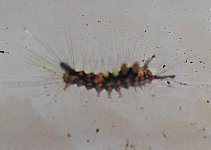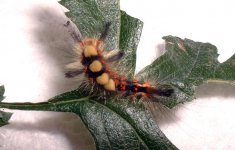Overwintered some vapourer eggs from last year and just finished hatching >100 pupae. We experimented with different foodplants and found they preferred sloe - they would eat birch, hawthorn and bramble but only when sloe wasn't available (actually started them on birch).
Had a lot of fun with the adults and it was a great education for the kids... It's too early for wild adults and so we released batches of our males (dayfliers) up to 1/4 mile downwind from the house and then put the flightless females outside. Amazing to see the males winging their way back home as they followed the females' pheremone plume. Every female attracted at least one male, and we know there were no wild males about because none came in (over a two day period) until we started releasing ours. How can these little moths accurately follow a weak "smell" over such a distance!? Mind-boggling, how does a brain the size of a pinhead do that? The kids (and me) were facinated by it.
Incidentally, anyone know of a good way of marking moths/butterflies for ID purposes? We tried snopake, paint and food dye but none was satisfactory (stuck wings together or just ran off the scales).
Gary





